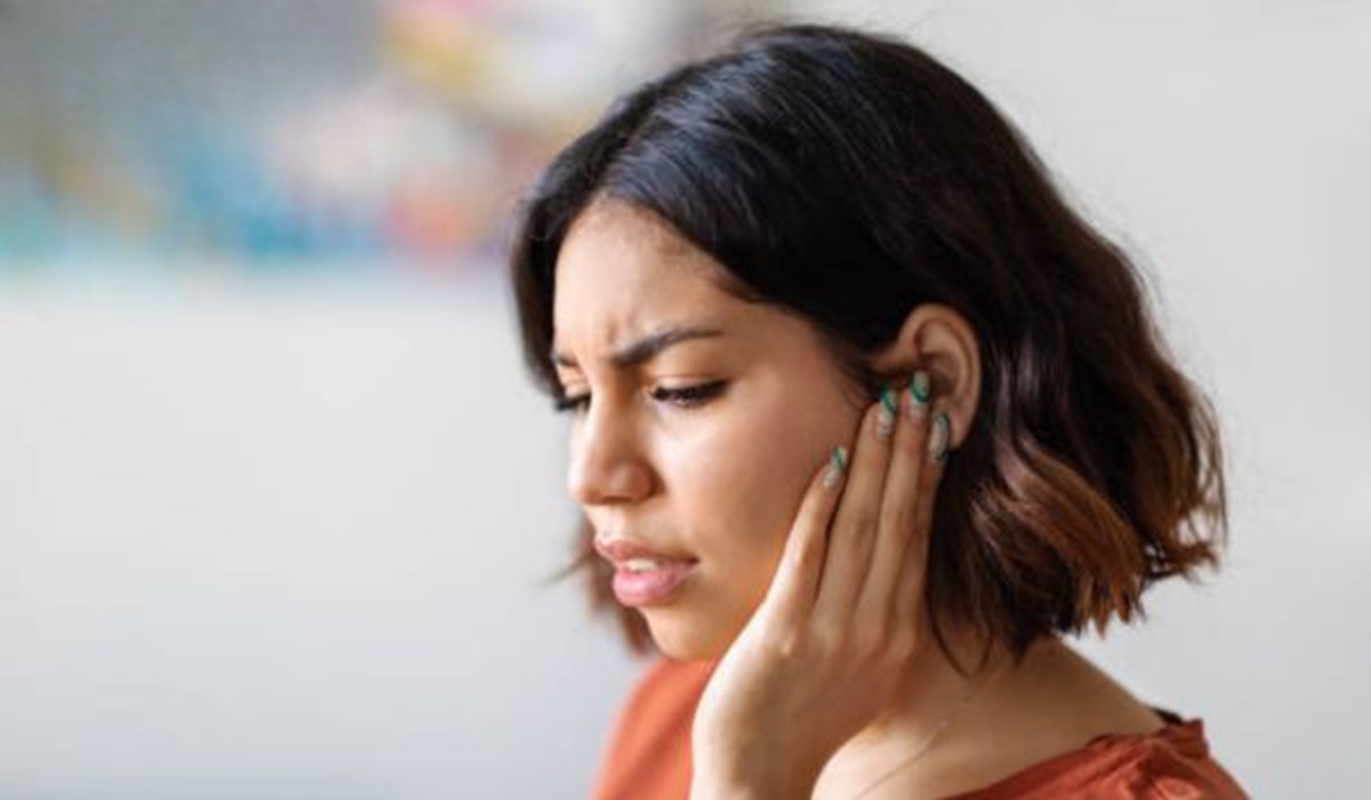
What is swimmer's ear?
With summer finally here, many people are spending their days relaxing at the beach or nearby pool. Because people will be spending more time in and around the water, it’s important to practice safe swimming. According to the Centers for Disease Control (CDC), swimmer’s ear symptoms account for nearly 2.4 million health care visits a year. Knowing what swimmer’s ear is and how to prevent it will help you and your ears have a safer, more enjoyable summer.
Swimmer's ear symptoms
Swimmer’s ear is the common name for a painful infection, inflammation or irritation that is caused when water gets trapped in the ear after swimming. As a result, bacteria or fungus may grow, causing itching and discomfort. This condition should be treated in its early stages while the impact is still minor. Doing so helps to relieve the pain and lessens the chance of hearing loss or further infection.
Swimmer’s ear is usually very easy to detect. Here are just a few of the more common symptoms of swimmer's ear:
- Itchiness inside your ear and pain that gets worse when you pull on your outer ear.
- Feeling like your ear is full or blocked; you could experience drainage from the ear.
- Fever, decreased hearing and severe pain that might spread to your face, neck or head.
- Pain with movement of your head, even when you chew.
How long does swimmer's ear last?
Swimmer’s ear, also known as otitis externa, is an infection of the outer ear canal often caused by water remaining in the ear after swimming. This moist environment encourages bacterial or fungal growth, leading to inflammation, itching, pain, and sometimes discharge.
In most cases, swimmer’s ear clears up within 7 to 10 days with proper treatment. Mild cases may improve in just a few days once medicated ear drops are applied. These drops often contain a combination of antibiotics to fight infection and steroids to reduce inflammation and discomfort. It’s important to use them as prescribed, even if symptoms improve quickly.
More severe cases—especially those that involve swelling, significant pain, or spreading infection—can take longer to heal, sometimes up to two to three weeks. In such instances, additional treatments like oral antibiotics or ear cleaning by a healthcare provider may be necessary.
To support recovery, avoid getting water in the affected ear during treatment, and do not insert cotton swabs or other objects into the ear canal. If symptoms persist beyond a week despite treatment, or if they worsen, consult your primary care physician, as untreated swimmer’s ear can lead to complications or become chronic.
How long does swimmer's ear last without treatment?
Without treatment, swimmer’s ear (otitis externa) can last several weeks and may worsen over time. In mild cases, the infection might eventually clear on its own, but this is not always the case. Most untreated cases will continue to cause discomfort, including persistent itching, pain, swelling, and discharge from the ear.
As the infection progresses, symptoms can intensify. Pain may increase—especially when touching or moving the ear—and the ear canal may become swollen or blocked, which can affect hearing. In some cases, the infection can spread beyond the ear canal to surrounding tissues, leading to more serious complications like cellulitis.
Additionally, swimmer’s ear that goes untreated has a higher risk of becoming chronic (lasting more than six weeks) or recurring frequently, especially in people who regularly swim, use hearing aids, or have underlying skin conditions like eczema.
For these reasons, medical treatment—usually involving prescription ear drops with antibiotics and anti-inflammatories—is strongly recommended. Early treatment can significantly reduce healing time, usually resolving symptoms within 7 to 10 days.
If left untreated, swimmer’s ear may linger for weeks, cause more severe pain, or lead to complications that require more intensive medical care.
Does swimmer's ear go away on its own?
Many people wonder, “Will swimmer's ear go away by itself?” The answer depends on the severity of the infection. Swimmer’s ear, or otitis externa, is an inflammation of the outer ear canal often caused by water trapped in the ear, which creates a moist environment for bacteria or fungi to grow.
In very mild cases, swimmer’s ear might improve on its own with good ear hygiene and by avoiding further moisture in the ear. However, this is not always the case. Most instances of swimmer’s ear require treatment with prescription ear drops that contain antibiotics, steroids, or antifungals to clear the infection and reduce inflammation. Without proper treatment, the infection can linger for several weeks or worsen. Symptoms such as pain, itching, swelling, and fluid discharge may increase, and in more serious cases, the infection can spread to surrounding tissues. This can lead to complications and a longer recovery period.
To prevent the condition from becoming more severe, it’s best to seek medical advice early. While mild symptoms might seem manageable, proper treatment can speed up healing and prevent the infection from returning. In most cases, swimmer’s ear will not go away entirely on its own without some form of medical intervention.
What does swimmer's ear look like?
Swimmer’s ear, also known as otitis externa, is an outer ear infection that causes visible and physical changes to the ear canal and outer ear. One of the earliest signs is redness around the opening of the ear canal, which may extend to the outer ear. The skin inside the canal can look swollen, inflamed, and irritated.
In many cases, the ear canal appears moist and may contain a clear, yellow, or pus-like discharge. This drainage can crust around the ear opening, especially if the infection is more advanced. The canal itself may appear narrowed due to swelling, which can sometimes be seen with the help of an otoscope during a medical examination.
Swimmer’s ear may also cause the outer ear to look slightly puffy or deformed, and the skin around the ear might become flaky or scaly. Some people develop visible blisters or sores in more severe cases.
Touching or pulling the ear may cause visible discomfort or pain, and in some cases, people may hold the affected ear slightly outward to avoid irritation. If you notice these signs—especially with pain, itching, or drainage—it’s important to consult your primary care provider to confirm the diagnosis and start appropriate treatment.
Swimmer's ear infection symptoms in children
Swimmer’s ear, or otitis externa, is a common ear infection in children, especially during the warmer months when swimming is frequent. It occurs when water becomes trapped in the outer ear canal, creating a moist environment where bacteria or fungi can grow.
In children, the first signs of swimmer’s ear are often ear pain and itching, especially when touching or tugging the ear. The pain may worsen when chewing, lying on the affected side, or brushing near the ear. Children may also complain of a full or blocked sensation in the ear, and some may experience temporary hearing loss due to swelling or fluid buildup in the canal.
Other symptoms include redness and swelling of the outer ear, along with clear, yellow, or pus-like drainage. In some cases, children may have a mild fever, though this is less common than with middle ear infections. Younger children who cannot describe their symptoms might become unusually irritable or frequently tug at their ears.
Prompt treatment with ear drops prescribed by a primary care physician usually clears the infection within a week. To prevent swimmer’s ear, ensure children dry their ears thoroughly after swimming or bathing and avoid inserting objects into the ears.
Swimmer's ear worst pain ever: what to do?
If you're experiencing severe pain from swimmer’s ear—often described by sufferers as the worst ear pain ever—it’s a sign the infection has progressed and needs requires immediate medical attention. Swimmer’s ear, or otitis externa, causes intense inflammation and swelling in the outer ear canal, which can lead to throbbing pain, blocked hearing, and difficulty sleeping or eating.
What to Do:
- See a Doctor Promptly: Visit your primary care physician as soon as possible. You’ll likely need prescription ear drops containing antibiotics, anti-inflammatories, or antifungal medication. Oral pain relievers may also be recommended.
- Avoid Getting the Ear Wet: Keep the affected ear completely dry. Use a shower cap or cotton ball coated with petroleum jelly during bathing. Avoid swimming until fully healed.
- Do Not Insert Anything Into the Ear: Cotton swabs, earbuds, or fingers can worsen irritation and push infection deeper.
- Use Warm Compresses: Applying a warm cloth or heating pad (on low) near the ear may help reduce pain temporarily.
- Rest and Monitor Symptoms: Rest and monitor for fever, spreading redness, or increased drainage. This may indicate the infection is worsening and requires further treatment.
Severe swimmer’s ear pain is treatable, but delaying care can lead to complications: act quickly.
Swimmer's ear vs ear infection: differences
Swimmer’s ear and ear infections are both common conditions, but they affect different parts of the ear and have distinct causes and symptoms.
Swimmer’s ear, or otitis externa, is an infection of the outer ear canal—the passage that connects the outer ear to the eardrum. It’s often caused by water trapped in the ear after swimming or bathing, creating a moist environment that allows bacteria or fungi to grow. Symptoms include itching, redness, swelling, discharge, and pain when touching or pulling the ear. Hearing may also be slightly reduced due to swelling or fluid buildup.
In contrast, a typical middle ear infection, or otitis media, affects the space behind the eardrum. It is more common in children and often occurs after a cold or respiratory infection. Symptoms usually include ear pain, fever, hearing loss, and sometimes fluid draining from the ear if the eardrum ruptures. Pain from a middle ear infection is usually deeper and is not affected by touching the outer ear.
The key difference lies in the location: swimmer’s ear affects the outer ear canal, while a middle ear infection affects the middle ear. Treatment also differs, so proper diagnosis by a primary care physician is essential.
Is swimmer's ear contagious?
Swimmer’s ear is not considered contagious in the traditional sense. It is an infection of the outer ear canal, typically caused by bacteria or, less commonly, fungi that grow in a moist environment—often after swimming or bathing. The condition arises due to water becoming trapped in the ear canal, which softens the skin and makes it more vulnerable to infection.
Since swimmer’s ear develops from internal factors like moisture, irritation, or minor injury to the ear canal (such as from cotton swabs or hearing aids), it cannot be spread from one person to another through casual contact. You cannot "catch" swimmer’s ear by being near someone who has it, sharing a swimming pool, or touching their ear.
However, good hygiene is still important. While the infection itself isn’t contagious, sharing items that go into the ear, like earbuds or hearing aids, can introduce bacteria and increase the risk of infection. To prevent swimmer’s ear, avoid inserting objects into the ears, dry ears thoroughly after water exposure, and use earplugs when swimming if you are prone to infections.
What to do for swimmer's ear in summer?
Swimmer’s ear is especially common in the summer, when swimming and water activities increase the risk of water getting trapped in the ear canal. If symptoms such as itching, pain, a feeling of fullness, or discharge begin, it's important to act quickly to prevent the infection from worsening.
Here’s what to do:
- Start treatment early – Use over-the-counter ear drops designed to dry moisture in the ear, but only if there's no eardrum perforation or active infection. For persistent symptoms, see a doctor for prescription ear drops with antibiotics and anti-inflammatory medication.
- Keep the ear dry – Avoid swimming and protect the ear while showering by using waterproof earplugs or a cotton ball coated with petroleum jelly.
- Do not insert anything into the ear – Cotton swabs and fingers can irritate the ear canal further and worsen the infection.
- Apply a warm compress – This can help relieve pain and reduce inflammation.
- Practice prevention – After swimming, dry ears thoroughly and tilt the head to help water drain. Consider using alcohol-vinegar ear drops to keep ears dry (only if ears are healthy and not already infected).
Acting quickly can reduce recovery time and keep summer activities on track.
How to prevent swimmer's ear in children and babies
Swimmer’s ear, or otitis externa, is a common outer ear infection in children and babies, especially during the warmer months when swimming and bathing are frequent. It occurs when water remains trapped in the ear canal, creating the perfect environment for bacteria or fungi to grow. Fortunately, there are simple steps parents can take to help prevent this painful condition.
After swimming or bathing, gently dry your child’s ears using a soft towel. For babies and toddlers, tilt their head to each side to help water drain out. Avoid inserting cotton swabs or any objects into their ears, as this can irritate the delicate skin and increase the risk of infection.
For children who swim regularly, consider using well-fitting earplugs and a swim cap to help keep water out. Over-the-counter ear-drying drops may also help, but they should only be used with a doctor's guidance, especially for young children.
Keep your child’s ears clean and dry, and avoid exposure to dirty or untreated water, such as lakes or poorly maintained pools. If your child is prone to ear infections, speak with a pediatrician or audiologist about additional preventive measures. With proper care, swimmer’s ear can often be avoided altogether.
What is the best antibiotic for swimmer's ear?
The most effective treatment for swimmer’s ear (otitis externa) typically involves prescription antibiotic ear drops, often combined with an anti-inflammatory medication to reduce pain and swelling. The best antibiotic depends on the type and severity of the infection, as well as whether the cause is bacterial or fungal.
For most bacterial cases, topical antibiotics applied directly into the ear canal are preferred over oral antibiotics. These ear drops target the infection at the source, helping clear symptoms more quickly while minimizing side effects. In some cases, the drops may also include a mild steroid to relieve inflammation and discomfort.
If the ear canal is very swollen or blocked with debris, a primary care physician may need to clean the ear first or insert a small sponge (wick) to help the drops reach deeper into the canal. Oral antibiotics are generally reserved for severe infections that have spread beyond the ear canal or when topical treatment isn’t effective.
It’s important to follow the full course of prescribed treatment, even if symptoms improve early. Always consult a primary care physician for proper diagnosis and the most appropriate antibiotic choice. Self-treating or using the wrong medication can delay healing or worsen the infection.
Ear drops for swimmer's ear and otitis externa: things to know
Ear drops are the primary treatment for swimmer’s ear, also known as otitis externa. They help eliminate the infection, reduce inflammation, and relieve symptoms like itching, pain, and swelling. For mild cases, over -the-counter (OTC) ear drops for swimmer’s ear may be helpful, especially those that contain drying agents like alcohol and acetic acid. These can be effective if used at the first sign of discomfort after water exposure.
However, for moderate to severe infections, prescription ear drops containing antibiotics and anti-inflammatory agents are usually required. Before using any ear drops, it's essential to ensure there is no eardrum perforation (hole in the eardrum)—this should be confirmed by a primary care physician.
One common question is how long to leave ear drops in for swimmer's ear. Typically, it’s recommended to lie on your side with the treated ear facing up for about five minutes after applying the drops. This helps the medication reach deep into the ear canal for maximum effect.
The best ear drops for swimmer’s ear are those prescribed based on the severity and type of infection. While OTC products may provide relief for early symptoms, persistent or worsening discomfort should always be assessed by a primary care physician.
How to get rid of swimmer's ear quickly
To get rid of swimmer’s ear quickly, early and proper treatment is essential. Swimmer’s ear, or otitis externa, is an infection of the outer ear canal that can cause pain, itching, swelling, and discharge. The key to fast relief is starting swimmer's ear treatment as soon as symptoms appear.
The most effective way to treat swimmer’s ear is with prescription ear drops that contain antibiotics to fight infection and often a mild steroid to reduce inflammation. These drops are applied directly into the ear canal, usually several times a day for seven to ten days. It's important to follow your healthcare provider’s instructions and complete the full course, even if symptoms improve early.
Before applying drops, the ear canal may need to be gently cleaned by a medical professional to remove debris and allow the medication to reach the infected area. In some cases, a soft wick may be inserted to help deliver the medicine more effectively.
To support healing, keep the ear dry—avoid swimming or getting water in the ear during treatment. Over-the-counter pain relievers can also help manage discomfort.
When started promptly, these swimmer’s ear treatments can significantly reduce symptoms and clear the infection quickly, often within a few days.
Home remedies for swimmer's ear and otitis externa
Swimmer’s ear (otitis externa) can sometimes be managed at home in its early stages, especially if symptoms are mild. The goal of home care is to keep the ear dry, reduce irritation, and prevent infection from worsening. One commonly used option is homemade swimmer’s ear drops made from equal parts white vinegar and rubbing alcohol. This mixture helps dry out moisture and restore the ear’s natural acidic environment, which discourages bacterial growth.
Another home remedy involves using hydrogen peroxide drops to gently clean the outer ear. A few drops can help loosen earwax and debris that may be trapping water. However, this method should be used with caution and should never be used if there is a known or suspected perforation in the eardrum.
To apply home remedies, tilt the head to one side and place a few drops into the affected ear, then stay in that position for a couple of minutes before draining. Always dry the ear gently with a clean towel.
While these remedies may relieve early symptoms, they are not substitutes for medical treatment. If pain, swelling, or discharge persists, it’s important to see a primary care physician for professional care and prescription medication.
Can you swim with swimmer's ear and otitis externa?
No, it is not recommended to swim with swimmer’s ear or otitis externa. Swimming can worsen the infection by introducing more moisture and bacteria into the already inflamed ear canal. Water exposure delays healing and increases the risk of the infection spreading or becoming chronic.
When the ear canal is infected, it’s also more sensitive and vulnerable to irritation. Continued contact with pool, lake, or even tap water can cause further pain and swelling. In some cases, it can wash out or reduce the effectiveness of prescribed ear drops used to treat the infection.
Doctors typically advise keeping the ear completely dry during the course of treatment, which usually lasts 7 to 10 days. To protect the ear while bathing or showering, use a cotton ball coated in petroleum jelly or a waterproof earplug - if approved by your healthcare provider.
Once symptoms have fully resolved and your doctor confirms that the infection is gone, it’s usually safe to return to swimming. To help prevent recurrence, dry ears thoroughly after swimming and avoid inserting objects like cotton swabs into the ear canal.
Can swimmer's ear cause a fever?
Yes, swimmer’s ear (otitis externa) can sometimes cause a fever, though it is not one of the most common symptoms. Swimmer’s ear primarily affects the outer ear canal and is usually associated with localized symptoms such as pain, itching, redness, swelling, and fluid discharge. However, in more severe or advanced cases, particularly when the infection spreads beyond the ear canal to nearby tissues, a low-grade fever may occur.
Fever is more likely in:
- Children, who tend to have more pronounced immune responses
- People with weakened immune systems
- Cases where the infection is left untreated or becomes severe
If a fever does develop, especially alongside worsening ear pain, swelling of the outer ear, or spreading redness around the ear or face, it may indicate the infection is progressing and requires urgent medical attention. In such cases, oral antibiotics or more intensive treatment may be needed.
Diagnosing swimmer's ear with otoscope and exams
Swimmer’s ear, or otitis externa, is typically diagnosed during a physical examination by a primary care physician. The main tool used is an otoscope, a handheld device with a light and magnifying lens that allows the provider to inspect the ear canal and eardrum.
During the exam, the provider will gently pull on the outer ear to assess pain response—a key symptom of swimmer’s ear. Using the otoscope, they will look for classic signs of infection, such as:
- Redness and swelling in the ear canal
- Flaky or peeling skin inside the ear
- Discharge (clear, yellow, or pus-like fluid)
- Obstruction from debris or excess earwax
- A normal or slightly obscured eardrum, since the infection is usually limited to the outer canal
If the ear canal is too swollen or blocked with fluid or debris, the provider may clean it gently to get a better view and allow treatment drops to work more effectively. In some cases, a sample of the discharge may be taken to identify the type of bacteria or fungus causing the infection. Imaging is rarely needed, as swimmer’s ear is usually diagnosed based on symptoms and a visual examination.
The above is the interpretation of How to Prevent and Treat Swimmer's Ear (Otitis Externa) provided by Chinese hearing aid supplier Shenrui Medical. Link https://www.srmcm.com/Blog/How_to_Prevent_and_Treat_Swimmer_s_Ear_Otitis_Externa.html of this article is welcome to share and forward. For more hearing aid related information, please visit Blog or take a look at our Hearing aids products















